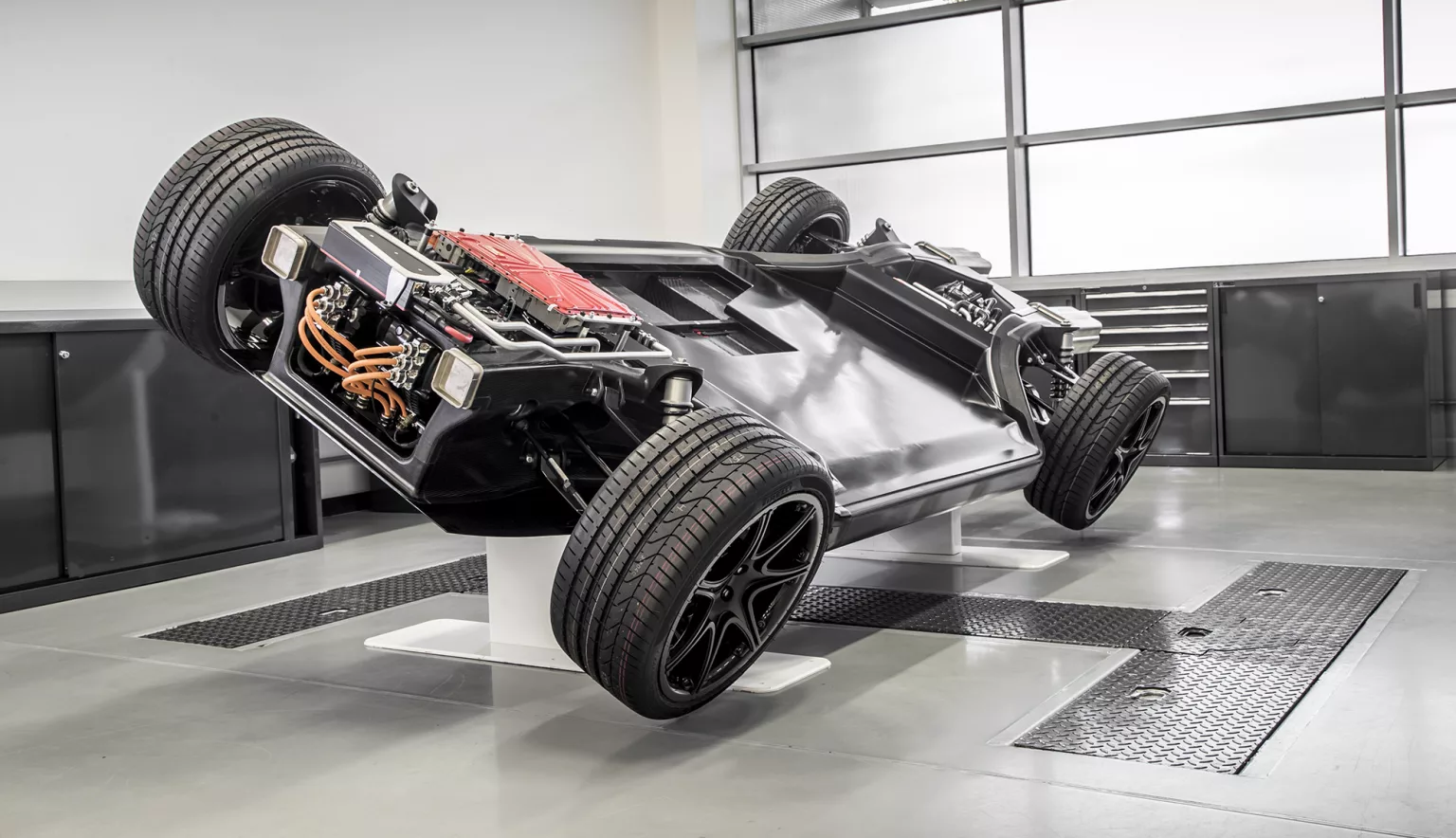Williams Advanced Engineering has a track record at the heart of the UK’s drive for energy efficient performance: the company is now set to guide an ever-increasing portfolio of clients into the next era of sustainability.
DRIVING INNOVATION
For more than 40 years, the name ‘Williams’ has been synonymous with engineering excellence in the UK and indeed around the world. And since 2010, the renowned motorsport heavyweight’s devoted Advanced Engineering arm has managed to translate tradition and legacy into one of the most forward-thinking and innovative propositions in the industry.
Initially set up to partner with Jaguar on its C-X75 hypercar project, the division – operating simultaneously and in alignment with its neighbouring Williams F1 operations – has diversified and expanded in such a way as to offer some of the most pertinent and challenging solutions to an-ever changing domain.
Now serving not just the automotive and motorsport space, but additionally areas of aerospace, defence, sports science, energy, marine and much, much more; the Company exists currently as a technology and innovation-driven solutions provider across engineering disciplines, rather than a sector-focused provider of tailored components.
Such acumen has inevitably attracted numerous high-end clients to the front door of Williams Advanced Engineering’s Oxfordshire-based headquarters in the UK. But, as Managing Director, Craig Wilson emphasises in an exclusive interview with EME Outlook, the overriding trends at present remain familiar and consistent from a solutions perspective.
“The big drivers all revolve around sustainability and energy efficiency, so this includes areas of lightweighting, aerodynamics, thermodynamics, and battery development; more often than not incorporated into the EV (electric vehicle) sector,” he says. “These capabilities are all borne out of our core business and are increasingly significant if you look at any area of transportation just now. It’s the way the industry is heading and I would say it gives us quite a good edge in the market.”
Upon entering the Company’s facilities at Grove, the spotlight on electric vehicles is hardly a secret; its FW-EVX concept platform dominating the lobby, and serving as an immediate indication of where the Company’s attentions and indeed strengths lie in this rapidly intensifying segment of global engineering.
“We are very proud of the FW-EVX for the components and elements it showcases; which we will look to improve-upon and exploit across other solutions in the future,” Wilson continues. “For instance, it highlights battery development manufacturing which is a key area for us alongside lightweight composites and materials. As well as the battery management system, the EVX also incorporates innovations across aerodynamics and thermodynamics as further ways to improve efficiencies and safety for this platform.
“It’s the efficiency of the platform but also the weight and the structure which revolves around the arrangement of composites, thermal performance and generally a more holistic approach to the concept.”
Of course, the art of efficiency is no new weapon on the automotive battlefield but as more and more Tier 1 manufacturers look to gain an advantage in the EV arena, the onus then transfers to the likes of Williams Advanced Engineering to facilitate the trend’s ongoing evolution.
Wilson says: “Vehicle efficiency has always been important for the internal combustion engine but nothing like the challenge with EVs which has taken the approach to efficiency to a new level for manufacturers and their products. And as more companies introduce more products, the challenge then becomes: “what’s the USP?”
“If it’s now the market staple, the differentiator for a vehicle isn’t going to be whether you have a V12 or a V6, but it’s going to be aspects of range, weight, aerodynamics, drag and battery life as the key indicators of performance.”
HIGH LEVEL TARGETS
In 2018, Williams Advanced Engineering is unique in what it is able to achieve, with no other dedicated operator blessed with the same in-house breadth of scope, resources, affiliations and capabilities. However, upon the department’s inception back in 2010, the focus wasn’t necessarily on fostering an autonomous, turnkey, industry-leading function; rather it was wholly directed towards its genesis: the Jaguar C-X75 programme.
Wilson notes: “The independence, assets and know-how were all here to be exploited and expanded upon but it did all start after being approached by Jaguar regarding the undertaking of the C-X75. Back then, Williams Advanced Engineering was a project. Now, it’s a business.”
It wasn’t as if the newly tailored arm was launching from a standing start of course; its industry experience and reputation in the Formula 1 space already presenting perfect foundations for these kinds of innovations to be applied elsewhere.
But in harnessing advanced aerodynamics, thermodynamics, lightweighting, electric propulsion, innovative chassis dynamics, simulation capabilities and overall vehicle integration under one car roof, the C-X75 proved to be a real eye opener as to what an arm like this could achieve on a more expansive basis.
“Although the C-X75 programme did not progress, we did produce five prototypes that could demonstrate performance that was quite spectacular at that time,” Wilson enthuses. “The high level targets were that this car could out-accelerate a Bugatti Veyron, would have the fuel emissions of a Toyota Prius, and would have an electrical range that could match a Chevrolet Volt. And all packaged into this beautiful exotic car.
“Our five prototypes demonstrated these high level targets and while it was a shame that the programme didn’t proceed, it did represent the modern start of Williams Advanced Engineering, and we’ve since taken a lot of what we learnt during that project and deployed it to a multitude of different projects.”
Subsequently combining four decades-worth of F1 expertise with this unparalleled exploration into a soon-to-be critical automotive trend, the consequential portfolio of capabilities now serves as a one-stop shop to prospective customers. To this end, as many as 40-50 projects for between 20 and 30 customers are being undertaken at any one time in the present day: the ultimate illustration of the C-X75’s initial significance, and the potential of more widespread engineering services that were always bubbling under the surface.
THE FUTURE OF TECHNOLOGIES
The best way to then optimise such potential is to expand influence and reach, and Williams Advanced Engineering has succeeded on this front, not necessarily via a concerted push into new sectors, but rather through an unwavering commitment to engineering progression that naturally facilitates solutions on a more multi-sector basis.
Cross-pollinating a whole host of developments across efficiency, structure, aerodynamics, battery systems and composites; the resultant expertise not only means an organic expansion of the Company’s client base, but a business-savvy spreading of risk from an income perspective.
“It has been a concerted effort not to have all our eggs in one basket and to not place undue risk on any one sector that we work within,” Wilson affirms. “That being said, we are also in a position where we can capitalise on the element of opportunistic growth when certain opportunities come along and when we have the capabilities in-house to meet their challenges.
“However, over the past couple of years we have started to become more strategic with what projects we’re targeting from a business perspective, focusing more on alignments from a technology point of view.”
Ensuring that every project is being completed to stringent market-leading standards as opposed to trying to be “all things to all men”, Wilson recalls a time immediately after the C-X75’s dissolution where momentum and developing a project portfolio was of the essence. But now that a track record has been cemented, a snowball effect has duly taken place.
“Back in those early days we were delivering on or commercialising what we knew and what we had around us, and while that continues to be the case today, we can now also turn attentions towards investing in the future of technologies,” the MD adds. “We’ve gone from offering simply what is best practice currently to now look at what technologies are going to keep us at the forefront in certain areas for the future as well. We can then come back to customers’ proposals with an even better technical offering, to deliver either as a single application or part of a bigger project.
“Through this approach, we are able to target our R&D and solutions towards applications that solve common problems across numerous sectors, rather than towards each sector individually.”
FRESH IMPETUS
R&D optimisation requires a bridging of the gap between proof of concept and the ultimate commercial routes for each project to be applied to respective sectors. And with this in mind, Williams Advanced Engineering collaborates with universities on an ongoing basis to form a mutually beneficial merger of technical facilitation, and skills enrichment.
Being an employer of choice naturally comes with the territory of being a Williams entity, but the business’s drive to up-skill young talent in the UK represents a much more all-encompassing ethos.
A large placement programme for university graduates has been in place to this end across both Williams Advanced Engineering and Williams F1, but running parallel are a host of investments and affiliations in place to fund PhD students through their own engineering journeys; to help accelerate research topics and to explore the possibility of moving them forward if successful.
“We weren’t doing this kind of thing at all in 2010 but we do much more of it now as part of our willingness to promote young engineers in the UK,” Wilson states. “We are a proud engineering company so we want to encourage the next generation of engineers, and to give them opportunities and careers.”
Operating alongside this business, the Foresight Williams Technology EIS Fund was set up to “support disruptive technology through high performance engineering and proven investing”, targeting start-up investors’ nascent projects and giving them a platform and direction to plot a route to commercialisation.
Wilson further details: “In our first couple of years we had a lot of people coming to us wondering if we could assist, but back then we didn’t have the means to invest in their business as well as our own. But a lot of these ideas were really great and from a UK perspective we knew it would be great to see these ideas succeeding. So now that we have the means, through this Fund, we can look to help these small businesses for the benefit of the industry in the UK generally.”
He continues: “It also keeps you sharp. It’s easy to get caught in your own bubble, but by integrating and communicating with these new ideas, it brings fresh impetus into what else is going on in the world for us and our partners.”
A MORE SUSTAINABLE UK
Wilson goes on to note that such affiliations and involvement in embryonic, exciting start-up-generated ideas reinstalls a certain ‘new company buzz’ that many present-day employees missed out on when Williams Advanced Engineering began back in 2010.
A comparable way to bring such emotions to the fore then becomes diversification, and the ability to continually reinvent the business; albeit in line with pre-existing, established, recognised attributes.
One such change of tack will see the Company branch out into the manufacture and supply domain in the coming years, once again capitalising on capabilities that are already present within the business.
“It’s not like we want to be a threat to Tier 1s from this perspective, but if we see a gap then we would certainly like to be in it,” Wilson confirms. “Simultaneously though, we are also working in collaboration with some Global Systems Suppliers in this space, supporting them with their own roadmaps.
“Ultimately, we just want to see the UK be more successful, and with an engineering capacity that’s not finite, we are willing to explore gaps in the supply market should they arise, all the while helping operators already in that space to improve their offering as well. Our role is to help produce a more sustainable UK.”
Diversification is no mean feat for many operators of Williams’ ilk and size, with flexibility and agility not the usual attributes of a large-scale provider. In this case though, the balance of a large enterprise influence with small company entrepreneurship is still alive and well.
As the Company grows and continues its success, it both returns money to the parent company and invests in itself to sustain that growth.
This ensures that the ultimate emphasis always stems back to continuous improvement; an advantage in rapidity that is all the more pivotal in the current climate, representing an investment into a nascent business leading the way into a fledgling new area of development for humanity.
“It’s a really exciting time we live in even though there are a lot of threats, because there’s so much development going on,” Wilson says. “It has been said that there’s going to be more development going on in the automotive space in the next 10 years than there’s been in the last 50, and it’s quite true.
“But at the same time it could be a volatile period as well. You have to have your eyes wide open and know exactly what’s going on because quite quickly you can get it wrong and be out of touch. If someone gets ahead of the pack in coming up with next best thing in battery technology – for example – it will then be a game-changer for everybody else.”
VOYAGE OF DISCOVERY
Williams has never been one to shy away from breaking new ground. Its recent Advanced Engineering developments are merely the latest in more than four decades of headline-making successes deriving from the Company’s glorious history in motorsport.
And even if one strand of the sporting assortment is performing slightly below expectations, Williams Advanced Engineering’s more widespread contributions ensure that there is always something positive to shout about; none more so in recent times than – aptly – its involvement in Formula E.
“Formula E is a great learning platform for us because I remember when the series was first launched and we were providing batteries, it was all a bit of a voyage of discovery,” Wilson says. “We had a restricted timeframe and did as much testing as possible, and our teams really began to push the boundaries of how to almost push the batteries to the limit and extract the most performance from them.
“In turn, it provided us with an accelerated platform to learn from and then apply to other aspects of the engineering business too.”
Testing is one thing, but the proof of success has come from an incredible track record that includes only two battery-related stoppages in three-and-a-half years of racing; both of which emanated from loose connectors on bumpy tracks and all the more impressive given that each driver has two cars per race.
Williams Advanced Engineering’s technical partnership with the Panasonic Jaguar Racing team in Formula E mirrors the spread of success that has largely driven the Company’s evolution over the past seven years, and is further epitomised by a similar partnership with Porsche and its Le Mans Prototype (LMP1) programme.
Wilson adds: “Porsche had three back-to-back Le Mans wins and many of our people who work in F1 typically, were able to revel in that success by virtue of their helping Porsche in our wind tunnel facilities. So, from a human satisfaction perspective, the same people that would love to see Williams F1 return to former glories, are still cheering on involvement elsewhere. Whether it’s the Panasonic Jaguar Racing Formula E team, three championships in a hugely competitive world endurance championship or in Formula E, where all the cars are powered by batteries made by our team that have not had an on-track failure in 24 consecutive races, our people are still delivering racing successes.”
SO MUCH AFFECTION
Essentially, as it has always done, achievement comes down to facing challenges head-on and in leveraging an intrinsic will to solve the biggest challenges in contemporary engineering. It’s a differentiator that not only maintains Williams’ status as a leading operator, but that continues to endear the business to UK as a whole.
Wilson concludes: “Williams has a great name, and a lot of integrity and ‘can-do’ that comes with it. It amazes me that to this day, after more than 40 years in business, not a bad word is said about the name no matter what is happening on the track at any particular time.
“It’s been a hugely successful company over the years but never in an arrogant way. Always hard-fought, and that’s why there is still so much affection for Williams across all levels. And for us, it’s about instilling this tradition into the innovative solutions with which we continue to attract customers.
“Our approach facilitates longstanding relationships, while our commitment to engineering is encapsulated in wanting to solve the biggest challenges out there, in a good, efficient, robust way. And that’s what we’ll continue to strive towards in the future.
“We’re never where we want to be, because that would mean stopping. We’re doing well, but we’ll never believe that we’ve reached our destination. There’s still more to do, in our fields there always will be. That’s what makes our business so fascinating.”





























